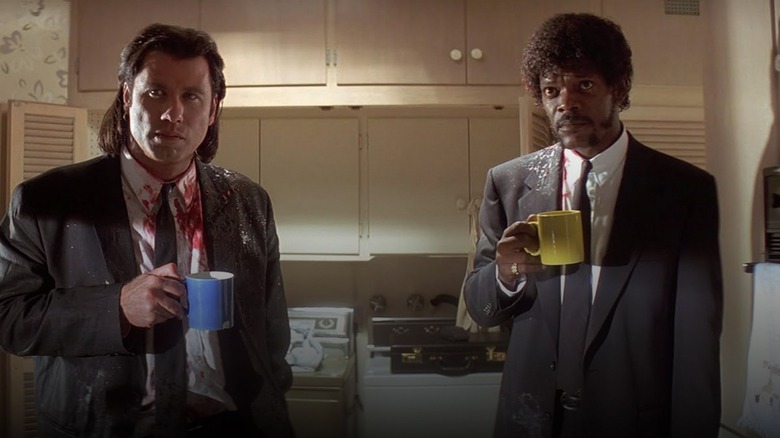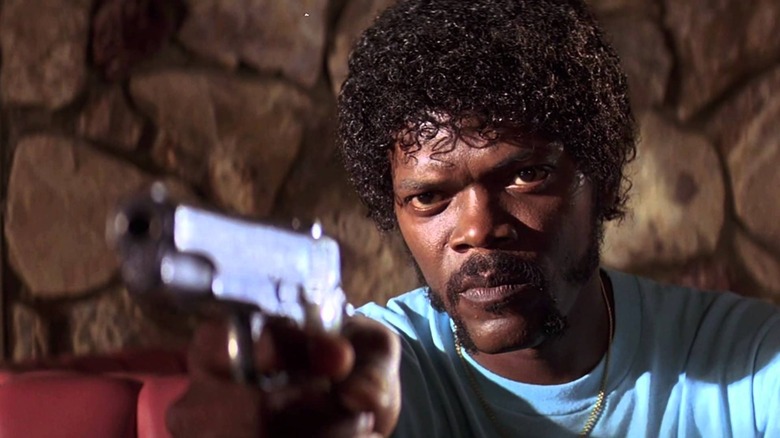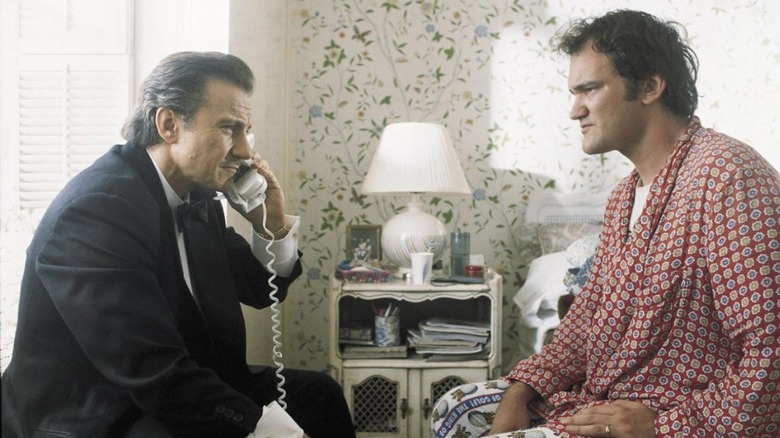Quentin Tarantino Wrote Pulp Fiction So No One Character Would Work On Their Own
Quentin Tarantino took a revolutionary and non-linear approach to narrative filmmaking in his first two features, "Reservoir Dogs" and "Pulp Fiction." The latter film tells three intertwining stories, the operative word here being "intertwining." None of these stories stand on their own, and Tarantino isn't afraid to admit that. What makes "Pulp Fiction" so unique is not each of its individual characters or stories, but the way they are woven together.
The writer-director has often said that his films are set in the "Quentin universe" as he described it to The New York Times. The characters all operate within the same world, apart from ours, that abides by a different logic — Tarantino's logic.
He's a film lover, but he wanted to take some beloved cinematic tropes and collage them together to create something more novelistic than traditionally dramatic. One homage, one quirky moment, and one big twist aren't enough for Tarantino — each piece of the puzzle relies on the other, and "Pulp Fiction" is no exception.
"As opposed to 'Reservoir Dogs,' which is a complete ensemble piece, ['Pulp Fiction'] works in a series of couples — everybody's a couple all the f****** way through," the acclaimed director pointed out to Film Comment. Tarantino conceded that Bruce Willis' character is alone for a little while, but not for long.
"Then he makes a bond with this other character and they become a team," he recounted. "It's only when they become a team that they can do anything. Circumstances make them a couple."
The characters in 'Pulp Fiction' are never alone
The characters in "Pulp Fiction" cannot stand alone because they're each fulfilling familiar cinematic tropes.
"The guy going out with the boss's wife and he's not supposed to touch her — that's in 'The Cotton Club,' 'Revenge,'" the filmmaker explained. "The middle story, the boxer who's supposed to throw the fight and doesn't — that's about the oldest chestnut there is."
The only exception, the only story of the three that follows a truly unconventional arc, is the story of two of the oldest fixtures in Hollywood: hitmen.
"The third story is more or less the opening three minutes of 'Action Jackson,' 'Commando,' every other Joel Silver movie — the hitmen show up and blow somebody away. Then they cut to 'Warner Bros. Presents' and you have the credit sequence, and then they cut to the hero 300 miles away. But [in 'Pulp Fiction'] the killers come in, BLAM-BLAM-BLAM — but we don't cut away, we stay with them the whole rest of the morning and see what happens to them after that. The whole idea is to have these old chestnuts and go to the moon with them."
Each of these "chestnuts" alone wouldn't do the job, though. Every character had a role to play in someone else's story — that's what kept "Pulp Fiction" so interesting. Seeing traditional cinematic tropes played out again is one thing, but seeing them interact? That was fresh and exciting.
"It was the idea of taking these chestnuts and putting them together and then actually having the characters kind of intertwine," Tarantino told American Film Institute. "It all kind of takes place in one city, and it's an environment that they all live in. The characters kind of know each other but you don't know that for a while."
The unconventional story makes these tired tropes interesting
Early Tarantino films told multiple stories out of sequential order. This was a novel idea for a film at the time since the majority of films are more or less linear and broken into three clear acts. However, other storytelling mediums have been known to break this convention.
"The bottom line is, my storyline jumps all over the place in 'Pulp Fiction,' back and forward," the filmmaker said in an interview with Charlie Rose. "Now, the truth of the matter is, if I had written 'Pulp Fiction' as a novel, and I was on your show, you would never even remotely bring up the structure." Viewers weren't used to seeing this kind of story play out on screen, but Tarantino hoped to change that convention without confusing the audience.
"Novelists have always had just a complete freedom to pretty much tell their story any way they saw fit, and that's kind of what I'm trying to do," he explained. That doesn't mean that every story needs to be told in a non-linear fashion — far from it. In fact, many of Tarantino's film since have had a more conventional structure.
"Now the thing is, for both novels and film, 75% of the stories that you're going to tell will work better on a dramatic engaging basis to be told from a linear way," the filmmaker explained. "But there is that 25% out there that can be more resonant by telling it this way. And I think in the case of both 'Reservoir Dogs' and 'Pulp Fiction,' it gains a lot more resonance being told in this, like, wild way."
"Pulp Fiction" works because each detail of the story is inseparable from the whole — that's what makes it such an intricate and irreparable narrative.


